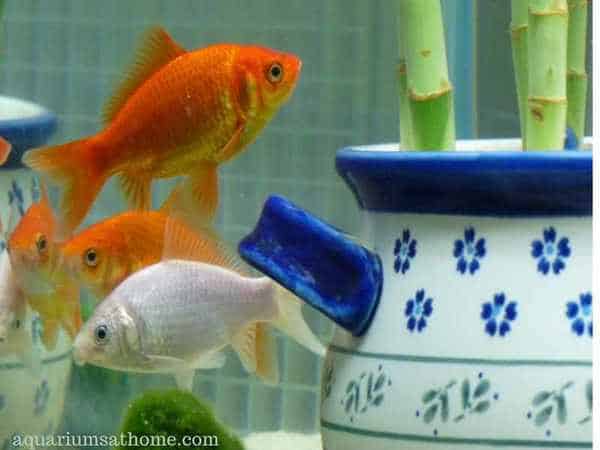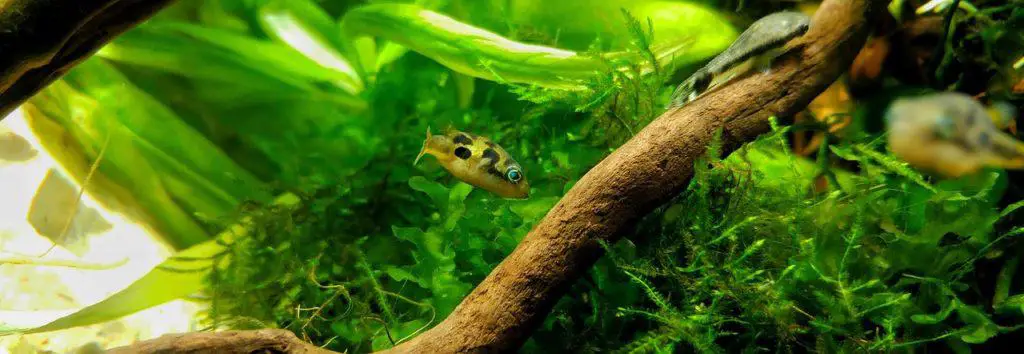There has been much talk in the aquarist world about using bamboo leaves in an aquarium. The sad truth, however, is that authentic bamboo isn’t an aquatic plant and will begin to rot shortly after being put in water. This begs the question, can you safely put bamboo plants (of any kind) in an aquarium?
You can safely submerge lucky bamboo (dracaena sanderiana) in your fish tank. This plant looks very much like real bamboo and is often mistaken for it at first glance. Just about any species of fish can be kept in a planted lucky bamboo tank.
Now that you know lucky bamboo can be used in a fish tank, let’s explore this topic further. Together, we’ll learn what is it, how to grow it, how long it lasts in an aquarium, which fish can be housed in tank with it, and what tank equipment is needed to sustain it.
So, if you’re ready to learn more about the benefits of using lucky bamboo in a freshwater aquarium, then let’s get to it!
Is Bamboo Safe for Fish Tanks?
True bamboo (bambusoideae) shouldn’t be used in a fish tank. It’s not aquatic safe and will start to rot immediately after being introduced to an aquarium. This negatively affects the water conditions by spiking the ammonia levels and dirtying the tank.
Instead of true bamboo, you should use lucky bamboo instead. This plant won’t alter the water parameters and grows well in almost any tank. As well, it creates a mutually beneficial relationship whereby the fish excrement feed the plant and in turn, the plant oxygenates the water for the fish.
What is Lucky Bamboo?
Lucky bamboo is a type of tropical water lily that originated in South Asia and not really a bamboo plant at all! It can be safely submerged – either fully or partially – in a fish tank and not only looks appealing, but also helps keep the aquarium clean and safe for all inhabitants by reducing dangerous nitrite levels.
Lucky bamboo can only be added to a freshwater tank – it won’t grow or survive in a brackish or saltwater aquarium. This plant works to oxygenate the water and provides cover for a variety of aquatic creatures in captivity. It’s the perfect addition to an aquascape or planted tank environment.

Can I Put Lucky Bamboo in My Betta Tank?
Since lucky bamboo is ideal for a freshwater aquarium, it’s the perfect choice for a betta tank. This plant is highly adaptable and can thrive in a betta tank environment, even an aquarium with no substrate. As well, lucky bamboo helps mimic the bettas natural habitat of shallow ponds with plenty of greenery.
Lucky bamboo in a betta tank not only helps keep the water clean and safe by oxygenating the water and neutralizing toxins, but it also offers fun and stimulation for the fish. They enjoy swimming around and through the greenery while providing them with cover and a sense of security.
Will Lucky Bamboo Hurt Fish?
Lucky bamboo won’t harm aquarium fish. In fact, it’s good for reducing ammonia toxicity while helping to oxygenate the water. It’s adaptability to a wide range of water conditions make it the perfect choice for a tank with any of the following ‘top 10’ fish species:
Lucky bamboo, if grounded in substrate, isn’t recommended for fish that like to uproot plants. Instead, consider floating it in the tank or anchoring it to a ledge attached to the aquarium with just the leaves submerged in the water – see below for more information.
Can Bamboo Leaves be Submerged in Water?
Real bamboo leaves shouldn’t be submerged in water as they’re not aquatic safe and will begin to rot almost immediately. Lucky bamboo, on the other hand, can be submerged either fully or partially in a tank and won’t rot or negatively affect the water parameters.
Lucky bamboo, though hardy and adaptable to most temperatures and pH levels in an aquarium, needs specific nutrients to grow and sustain itself. It prefers high amounts of oxygen and moderate to high levels of carbon dioxide. Dosing it with a liquid CO2 and adding an air pump to the tank is encouraged.
How Long does Lucky Bamboo Live in an Aquarium?
On average, a well-cared-for lucky bamboo plant will live up to 2 years in an aquarium. The better the substrate, the longer it can sustain itself. When planted into a soft-sand or fine-gravel bottom, it has a much better longevity rate – though it can survive with no base and in just a few inches of water!
Since lucky bamboo needs moderate to high levels of both oxygen and carbon dioxide to grow, you’ll need to provide it with both. Adding liquid CO2 like API CO2 Booster is recommended. As well, installing an air pump to the tank will help increase surface agitation and allow O2 molecules to dissolve better.
How to Grow Lucky Bamboo for a Fish Tank?
To grow lucky bamboo for a fish tank, begin by purchasing a package of greenery such as Marineland Bamboo online at Amazon or at your local pet shop. Submerge it fully in the water and supply it with ample amounts of carbon dioxide. Dosing or injecting the plant with a CO2 booster is your best bet.
You can encourage lucky bamboo growth with an aquarium-safe plant fertilizer like Seacham Flourish. A cap-full every other day is all you need! Turning on your air pump to create surface agitation is a must. Replacing your existing filter with a higher capacity unit or adding a spray bar to the outlet will also help.

How to Use a Ledge Attachment for Lucky Bamboo in a Fish Tank?
When you submerse the entire stalk of a lucky bamboo plant, you could end up killing it. Yes, it’s true. While lucky bamboo plants are aquatic safe, it’s recommended that you submerge only the leaves, if possible. Some lucky bamboo plants, however, are okay when fully submerged whereas others aren’t.
A way to avoid running into an issue is to attach a ledge in your tank around 6” or so from the top. The ledge can contain the substrate with the bamboo plant resting on top of the ledge. The roots will grow into the substrate and not too much of the stalk will be submersed in water.
Another idea is to find rubber suction cups made for aquarium heaters or tubes that have about the same circumference as the plant. Attach the bamboo stalk to the open end of the suction cup and the suction cup closer to the top of the tank. This will allow the roots to grow freely in the water.
Conclusion
To sum things up, real bamboo isn’t ‘aquarium safe’ and will begin to rot almost immediately when submerged in water. Lucky bamboo is a true bamboo substitute that can be used safely in a fish tank. Not only does it look appealing, but it also helps lower ammonia levels to keep the tank clean and safe.
I hope this article has answered your questions about lucky bamboo and how it benefits a freshwater aquarium. Thanks for reading and best of luck with your aquarist hobby!
Recommended Posts
How to Grow Live Plants in Freshwater Aquarium [Tips Included]
DIY Aquarium Plant Cleaning: Save Money & Keep Your Tank Pristine






